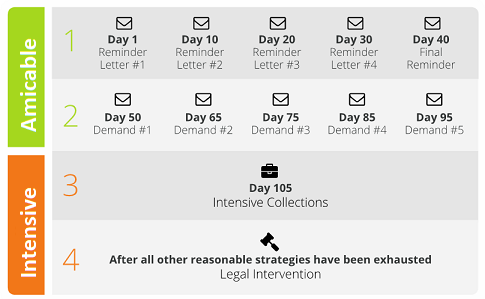
Patients requiring emergency treatment or ambulance services often see their financial condition deteriorate very quickly because of large medical bills that follow after things settle.
The biggest mistake which most ambulance services make is relying on their own accounting staff to send reminder invoices or make calls to patients, which are quite ineffective if a patient does not settle his bill within two months. Such patients are likely piling up additional medical bills. Not transferring such accounts within 2-3 months to a professional medical debt collection agency can be a huge mistake that many emergency care service providers make.
Need a Collection Agency for unpaid Ambulance Service bills?Serving Nationwide: Contact us |
Sending low-cost Collection Demands through a collection agency once an ambulance bill has been due for over 60-90 days can tremendously reduce delinquencies and improve cash flow. Shifting to more intensive collection efforts like “Collection Calls” and “Legal Action” is recommended after a patient has not paid for more than 180 days. In most cases, patients will clear bills during the Collection Letters service itself because they very well know that Collection Agencies will soon start making calls or sue the debtor in court if bills are not paid quickly. It is never too late to hire a collection agency that has expert debt collectors specifically for the healthcare industry.
Every year, about 240 million people call 9-1-1 in the U.S. For most of these calls, an ambulance is dispatched to the scene in order to provide immediate medical attention. Patients and medical professionals alike are indebted to these services, which means that they should be paid appropriately and on time. But do you know how ambulance services collect patient payments?
Yes, the billing company has a right to send the case over to a collection agency. If the patient is unable to pay at once then it’s better to carve out a payment plan with him.
The process is relatively simple and strategic, and the job is usually assigned to an EMS bill company. However, not all billing companies are concerned about timelines. Neglecting to send out billing information for services rendered by EMS professionals hurts the response team, the hospital, the patient, and even the taxpayers. That’s why it’s vital to ensure that your billing or collection agency is following these three steps for collecting patient payments for ambulance services.
Step 1. Double Check The Bill
Ensuring that your patients are receiving the appropriate bill is going to save time and hassle on everyone’s end. For this to happen, your billing company needs to check and double-check the status of the remaining bill after it’s been through the initial steps.
Insurance Payment
A reliable company will do some background checks to make sure that the insurance company has paid out the proper amount. If the numbers are wrong, it’s your patient who is going to get frustrated, and it’s you who they will be calling to demand an explanation. A hands-on billing company will make sure that the distressed patient is at least getting the correct billing information.
Spelling, Contact, and Coding
Another thing that should be checked is for any typing errors within the bill. A seemingly minor error can lead to denials or claims, meaning that the 911 provider will be delayed in receiving payment (if they get it at all). Your billing company should be diligent in making sure all information is correct before sending it out to the patient.
Step 2. Five Day Bill Day
Speaking of sending out the bill, ambulance services can collect patient payments at any time. Ideally, however, your billing company should have the bill squared away with the proper information within five days. If you’re working with a company that is continuously sending out patient bills for ambulance services weeks or months after the event, you should consider switching agencies.
Step 3. Follow-Up
Once the bill has been sent out to the patient, it’s up to your EMS billing to follow up on payments. Most patients aren’t likely to pay this bill as soon as they receive it. However, your company’s standard procedure should include follow-ups. This shouldn’t be a problem if they have a fully-geared accounts receivable report (that they update regularly).
Here is a list of follow-up procedures your company should be providing:
Bill Received: Confirmation and date that bill was sent out and date patient should have received it.
Follow-Up Communication: Every call, email, or reminder bill that your company has issued to the patients as a reminder for payment (AR report).
Claims and Denial Listings: Any claim or denials in the process that has caused a delay in payment of the ambulance services.
Days To Payment: Medicare reimbursement should take no longer than 14 days, while commercial insurance companies should take less than 45 days. If their estimated time of payment from insurance providers exceeds those numbers, it’s likely that their follow-up process needs some work.
When deciding to work with an EMS billing company, you need to set strict expectations. Ask to see an example of the AR reports, asking about payment estimates, and also be sure to enquire about their collection percentages. And remember, if their services seem too good to be true, it probably is.
Still no luck recovering your money?
When a patient has failed to pay for 90 days despite all your efforts, hire a Debt Collection Agency without wasting more time.
| Collection Letters Service of Collection Agency |
|
| Collection Calls Service of Collection Agency |
|
If you need a Collection Agency with experience in your area: Contact us


